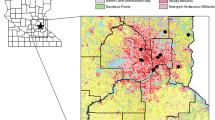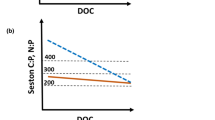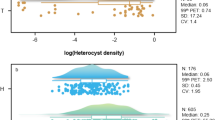Abstract
A whole-ecosystem experiment in Lake 227 (L227) at the Experimental Lakes Area, ongoing since 1969, examined the roles of carbon (C), nitrogen (N), and phosphorus (P) in controlling eutrophication. During 2011, we conducted a series of sub-experiments and more intensive monitoring to improve estimates of N fixation and its ability to meet algal growth demands in the decades following the cessation of artificial N loading, while maintaining long-term high artificial P loading. Stoichiometric nutrient ratios indicated both moderate N and P limitation of the phytoplankton during spring, preceding a shift in phytoplankton community structure toward dominance by N fixing cyanobacteria. During bloom development, and for the remainder of the stratified period, stoichiometric nutrient ratios indicated moderate to strong P limitation. N fixation rates, corrected using 15N2 methods, increased 2× after 1990, when N loading ceased. Ambient dissolved inorganic nitrogen prior to the bloom represented less than 3% of N demands of the phytoplankton. N fixation accounted for between 69–86% of total N loading to the epilimnion during the period of rapid bloom development, and 72–86% of total N loading during the May–October period. Phytoplankton biomass did not decline in L227 during the 40 years since artificial N loading was reduced, or the nearly 25 years since artificial N loads ceased entirely (1990–2013), and remained approximately 20× higher than four nearby reference lakes. These results suggest that despite constraints on biological N fixation, it retains a large capacity to offset potential N loading reductions in freshwaters.







Similar content being viewed by others
References
Agawin NS, Rabouille S, Veldhuis MJ, Servatius L, Hol S, van Overzee HM, Huisman J. 2007. Competition and facilitation between unicellular nitrogen-fixing cyanobacteria and non-nitrogen-fixing phytoplankton species. Limnology and Oceanography 52:2233–48.
Beversdorf LJ, Miller TR, McMahon KD. 2013. The role of nitrogen fixation in cyanobacterial bloom toxicity in a temperate, eutrophic lake. PLoS ONE 8:e56103.
Carpenter SR. 1996. Microcosm experiments have limited relevance for community and ecosystem ecology. Ecology 77:677–80.
Carpenter SR, Caraco NF, Correll DL, Howarth RW, Sharpley AN, Smith VH. 1998. Nonpoint pollution of surface waters with phosphorus and nitrogen. Ecological Applications 8:559–68.
Conley DJ, Paerl HW, Howarth RW, Boesch DF, Seitzinger SP, Karl E, Karl E, Lancelot C, Gene E, Gene E. 2009. Controlling eutrophication: nitrogen and phosphorus. Science 123:1014–15.
Dove A, Chapra SC. 2015. Long-term trends of nutrients and trophic response variables for the Great Lakes. Limnology and Oceanography 60:696–721.
Elser JJ, Sterner RW, Galford AE, Chrzanowski TH, Findlay DL, Mills KH, Paterson MJ, Stainton MP, Schindler DW. 2000. Pelagic C:N:P stoichiometry in a eutrophied lake: responses to a whole-lake food-web manipulation. Ecosystems 3:293–307.
Findlay D, Hecky R, Hendzel L, Stainton M, Regehr G. 1994. Relationship between N2-fixation and heterocyst abundance and its relevance to the nitrogen budget of Lake 227. Canadian Journal of Fisheries and Aquatic Sciences 51:2254–66.
Flett RJ, Schindler DW, Hamilton RD, Campbell NE. 1980. Nitrogen fixation in Canadian Precambrian shield lakes. Canadian Journal of Fisheries and Aquatic Sciences 37:494–505.
Grimm NB, Petrone KC. 1997. Nitrogen fixation in a desert stream ecosystem. Biogeochemistry 37:33–61.
Healey F. 1975. Physiological indicators of nutrient deficiency in algae. Fisheries and marine service technical reports: Fisheries and Oceans Canada, p 30
Healey F, Hendzel L. 1980. Physiological indicators of nutrient deficiency in lake phytoplankton. Canadian Journal of Fisheries and Aquatic Sciences 37:442–53.
Helsel DR, Hirsch RM. 1992. Statistical methods in water resources. Amsterdam: Elsevier.
Hendzel L, Hecky R, Findlay D. 1994. Recent changes of N2-fixation in Lake 227 in response to reduction of the N: P loading ratio. Canadian Journal of Fisheries and Aquatic Sciences 51:2247–53.
Higgins SN, Hecky RE, Taylor WD. 2001. Epilithic nitrogen fixation in the rocky littoral zones of Lake Malawi, Africa. Limnol Oceanogr 46:976–82.
Howarth RW, Marino R, Cole JJ. 1988a. Nitrogen fixation in freshwater, estuarine, and marine ecosystems. 2. Biogeochemical controls. Limnology and Oceanography 33:688–701.
Howarth RW, Marino R, Lane J, Cole JJ. 1988b. Nitrogen fixation in freshwater, estuarine, and marine ecosystems. 1. Rates and importance. Limnology and Oceanography 33:669–87.
Jassby AD, Platt T. 1976. Mathematical formulation of the relationship between photosynthesis and light for phytoplankton. Limnology and Oceanography 21:540–7.
Kendall MG. 1948. Rank correlation methods. London: Charles Griffin & Company Limited.
Lewis WM, Wurtsbaugh WA. 2008. Control of lacustrine phytoplankton by nutrients: erosion of the phosphorus paradigm. International Review of Hydrobiology 93:446–65.
Loeb SL, Reuter JE. 1981. The epilithic periphyton community: a five-lake comparative study of community productivity, nitrogen metabolism, and depth-distribution of standing crop. Verh Int Ver Limnol 21:346–52.
McDonald KE, Lehman JT. 2013. Dynamics of Aphanizomenon and Microcystis (cyanobacteria) during experimental manipulation of an urban impoundment. Lake and Reservoir Management 29:103–15.
Miller TR, Beversdorf L, Chaston SD, McMahon KD. 2013. Spatiotemporal molecular analysis of cyanobacteria blooms reveals Microcystis-Aphanizomenon interactions. PLoS One 8:e74933.
Mohr W, Grosskopf T, Wallace DW, LaRoche J. 2010. Methodological underestimation of oceanic nitrogen fixation rates. PLoS One 5:e12583.
Moisander PH, Ochiai M, Lincoff A. 2009. Nutrient limitation of Microcystis aeruginosa in northern California Klamath River reservoirs. Harmful Algae 8:889–97.
Molot LA. 2017. The effectiveness of cyanobacteria nitrogen fixation: review of bench top and pilot scale nitrogen removal studies and implications for nitrogen removal programs. Environmental Reviews 25:292–5.
Mugidde R, Hecky RE, Hendzel LL, Taylor WD. 2003. Pelagic nitrogen fixation in Lake Victoria (East Africa). Journal of Great Lakes Research 29:76–88.
O’Neil JM, Davis TW, Burford MA, Gobler CJ. 2012. The rise of harmful cyanobacteria blooms: the potential roles of eutrophication and climate change. Harmful Algae 14:313–34.
Paerl HW, Gardner WS, McCarthy MJ, Peierls BL, Wilhelm SW. 2014. Algal blooms: noteworthy nitrogen. Science 346:175.
Paerl HW, Huisman J. 2009. Climate change: a catalyst for global expansion of harmful cyanobacterial blooms. Environmental Microbiology Reports 1:27–37.
Paerl HW, Otten TG. 2016. Duelling ‘CyanoHABs’: unravelling the environmental drivers controlling dominance and succession among diazotrophic and non-N2-fixing harmful cyanobacteria. Environmental microbiology 18:316–24.
Paterson M, Findlay D, Salki A, Hendzel L, Hesslein R. 2002. The effects of Daphnia on nutrient stoichiometry and filamentous cyanobacteria: a mesocosm experiment in a eutrophic lake. Freshwater Biology 47:1217–33.
Paterson MJ, Schindler DW, Hecky RE, Findlay DL, Rondeau KJ. 2011. Comment: Lake 227 shows clearly that controlling inputs of nitrogen will not reduce or prevent eutrophication of lakes. Limnology and Oceanography 56:1545–7.
Poste A, Hecky R, Guildford S. 2013. Phosphorus enrichment and carbon depletion contribute to high Microcystis biomass and microcystin concentrations in Ugandan lakes. Limnol Oceanogr 58:1075–88.
R Core Development Team. 2015. R: A language and environment for statistical computing. R Foundation for Statistical Computing, Vienna, Austria. http://www.R-project.org/.
Sattari S, Bouwman A, Rodríguez RM, Beusen A, van Ittersum M. 2016. Negative global phosphorus budgets challenge sustainable intensification of grasslands. Nature Communications 7:1–12. https://doi.org/10.1038/ncomms10696.
Schindler D. 1977. Evolution of phosphorus limitation in lakes. Science 195:260–2.
Schindler DW. 2012. The dilemma of controlling cultural eutrophication of lakes. Proc Biol Sci 279:4322–33.
Schindler DW, Brunskill G, Emerson S, Broecker W, Peng T-H. 1972. Atmospheric carbon dioxide: its role in maintaining phytoplankton standing crops. Science 177:1192–4.
Schindler DW, Carpenter SR, Chapra S, Hecky RE, Orihel DM. 2016. Reducing phosphorus to curb lake eutrophication is a success. Environmental Science and Technology 50:8923–9.
Schindler DW, Hecky RE, Findlay DL, Stainton MP, Parker BR, Paterson MJ, Beaty KG, Lyng M, Kasian SE. 2008. Eutrophication of lakes cannot be controlled by reducing nitrogen input: results of a 37-year whole-ecosystem experiment. Proc Natl Acad Sci USA 105:11254–8.
Schindler DW, Kling H, Schmidt R, Prokopowich J, Frost V, Reid R, Capel M. 1973. Eutrophication of Lake 227 by addition of phosphate and nitrate: the second, third, and fourth years of enrichment, 1970, 1971, and 1972. Journal of the Fisheries Board of Canada 30:1415–40.
Schindler DW, Vallentyne JR. 2008. The algal bowl. Edmonton: University of Alberta Press.
Scott JT, Doyle RD, Prochnow SJ, White JD. 2008. Are watershed and lacustrine controls on planktonic N2-fixation hierarchically structured? Ecological applications 18:805–19.
Scott JT, Grantz EM. 2013. N2 fixation exceeds internal nitrogen loading as a phytoplankton nutrient source in perpetually nitrogen-limited reservoirs. Freshwater Science 32:849–61.
Scott JT, McCarthy MJ. 2010. Nitrogen fixation may not balance the nitrogen pool in lakes over timescales relevant to eutrophication management. Limnology and Oceanography 55:1265–70.
Stainton MP, Capel MJ, Armstrong F. 1977. The chemical analysis of freshwater. Misc. Special Publ. 25, p 180
Tilman D. 1999. Global environmental impacts of agricultural expansion: the need for sustainable and efficient practices. Proceedings of the National Academy of Sciences 96:5995–6000.
Tilman D, Fargione J, Wolff B, D’Antonio C, Dobson A, Howarth R, Schindler D, Schlesinger WH, Simberloff D, Swackhamer D. 2001. Forecasting agriculturally driven global environmental change. Science 292:281–4.
Vitousek PM, Cassman K, Cleveland C, Crews T, Field CB, Grimm NB, Howarth RW, Marino R, Martinelli L, Rastetter EB. 2002. Towards an ecological understanding of biological nitrogen fixation. Biogeochemistry 57:1–45.
Watson SB, Whitton BA, Higgins SN, Paerl HW, Brooks BW, Wehr JD. 2015. Harmful algal blooms. In: Wehr JD, Sheath RG, Eds. Freshwater algae of North America. Cambridge: Academic Press.
Acknowledgements
Funding for this research was provided by: the Fisheries Research Board of Canada to DWS; the Canadian Department of Fisheries and Oceans to DWS, MJP, DLF, and SNH; the Provinces of Ontario and Manitoba; and the IISD Experimental Lakes Area Inc. to MJP and SNH during different periods of the long-term experiment. Stable isotope analysis was provided by the University of Waterloo Environmental Isotope Laboratory (UW-EIL). We thank the numerous individuals involved in field sampling and water chemistry analysis.
Author information
Authors and Affiliations
Corresponding author
Additional information
Author contributions
SNH conducted 2011 experiments, analyzed data, and wrote the manuscript; MJP, REH, DWS conceived and undertook the long-term study and analyzed the long-term data; DLF analyzed algal taxonomy and heterocyst abundance: JJV and SNH conducted and analyzed the 15N2 experiment.
Electronic supplementary material
Below is the link to the electronic supplementary material.
Rights and permissions
About this article
Cite this article
Higgins, S.N., Paterson, M.J., Hecky, R.E. et al. Biological Nitrogen Fixation Prevents the Response of a Eutrophic Lake to Reduced Loading of Nitrogen: Evidence from a 46-Year Whole-Lake Experiment. Ecosystems 21, 1088–1100 (2018). https://doi.org/10.1007/s10021-017-0204-2
Received:
Accepted:
Published:
Issue Date:
DOI: https://doi.org/10.1007/s10021-017-0204-2




